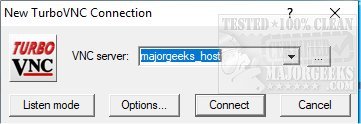TurboVNC 3.2 has been released, offering a high-performance, enterprise-quality VNC solution for both Windows and Linux. This software is built on the foundations of TightVNC, TigerVNC, and X.org, enabling efficient connections to VNC servers. One of the key features of TurboVNC is its use of a Tight encoding variant, which enhances performance and compression especially for demanding tasks such as 3D applications (via VirtualGL), video playback, and other image-heavy workloads. When used alongside VirtualGL, TurboVNC delivers a powerful solution for remotely accessing and displaying 3D applications with interactive performance.
Since its inception in 2004 as a fork of TightVNC, TurboVNC has integrated all features from TightVNC 1.3.x while introducing various enhancements and bug fixes. It outperforms TightVNC significantly in compressing 3D and video workloads, typically consuming only 5-20% of the CPU resources that TightVNC would require. On modern hardware, TurboVNC can stream over 50 Megapixels per second across a 100 Megabit/second LAN connection while maintaining perceptually lossless image quality. For internet connections of 5 Megabits/second, it can still deliver between 10 to 12 Megapixels per second, albeit at a lower image quality.
Key features of TurboVNC include:
- Fine-grained JPEG image quality control and chrominance subsampling settings.
- Double buffering on the client side to minimize tearing in 3D and video applications.
- Flexible full-screen and multi-screen support.
- Full IPv6 support.
- Advanced flow control and continuous updates, enhancing performance over high-latency connections.
- Various authentication options including one-time passwords and Unix credentials, in addition to standard VNC passwords.
- Access control lists for session sharing.
- Global security and authentication policy settings for servers.
- Multithreaded encoding capabilities.
- A "lossless refresh" option for obtaining a high-fidelity copy of the screen image.
- A high-performance, zero-install Java viewer that utilizes Java Web Start for deployment, leveraging libjpeg-turbo for optimal performance.
Given the rapid advancements in remote desktop technology, TurboVNC stands out as a robust solution tailored for enterprises needing reliable remote access to graphical applications. With its ongoing improvements and user-centric features, TurboVNC is well-positioned to meet the diverse needs of users in various industries, particularly those requiring high-quality visual performance in remote environments
Since its inception in 2004 as a fork of TightVNC, TurboVNC has integrated all features from TightVNC 1.3.x while introducing various enhancements and bug fixes. It outperforms TightVNC significantly in compressing 3D and video workloads, typically consuming only 5-20% of the CPU resources that TightVNC would require. On modern hardware, TurboVNC can stream over 50 Megapixels per second across a 100 Megabit/second LAN connection while maintaining perceptually lossless image quality. For internet connections of 5 Megabits/second, it can still deliver between 10 to 12 Megapixels per second, albeit at a lower image quality.
Key features of TurboVNC include:
- Fine-grained JPEG image quality control and chrominance subsampling settings.
- Double buffering on the client side to minimize tearing in 3D and video applications.
- Flexible full-screen and multi-screen support.
- Full IPv6 support.
- Advanced flow control and continuous updates, enhancing performance over high-latency connections.
- Various authentication options including one-time passwords and Unix credentials, in addition to standard VNC passwords.
- Access control lists for session sharing.
- Global security and authentication policy settings for servers.
- Multithreaded encoding capabilities.
- A "lossless refresh" option for obtaining a high-fidelity copy of the screen image.
- A high-performance, zero-install Java viewer that utilizes Java Web Start for deployment, leveraging libjpeg-turbo for optimal performance.
Given the rapid advancements in remote desktop technology, TurboVNC stands out as a robust solution tailored for enterprises needing reliable remote access to graphical applications. With its ongoing improvements and user-centric features, TurboVNC is well-positioned to meet the diverse needs of users in various industries, particularly those requiring high-quality visual performance in remote environments
TurboVNC 3.2 released
TurboVNC is a high-performance, enterprise-quality version of VNC for Windows and Linux based on TightVNC, TigerVNC, and X.org that allows efficient VNC server connections.


